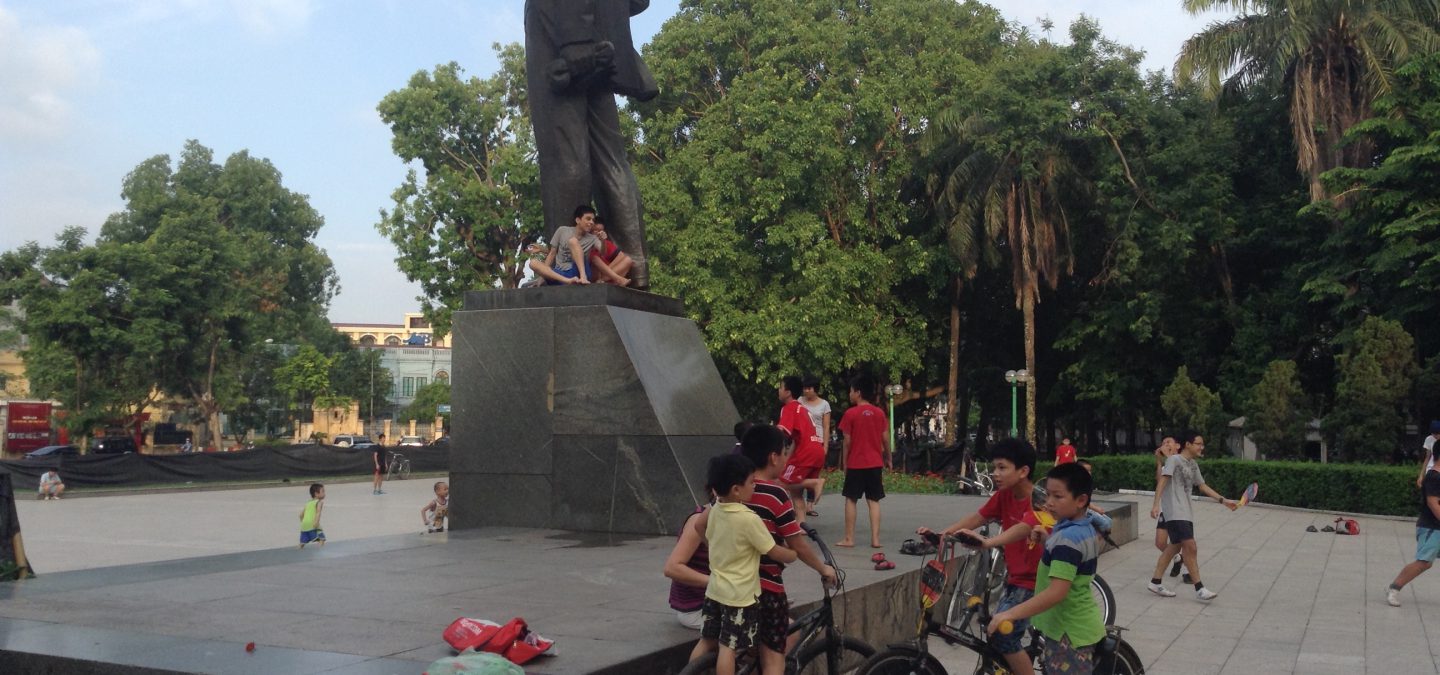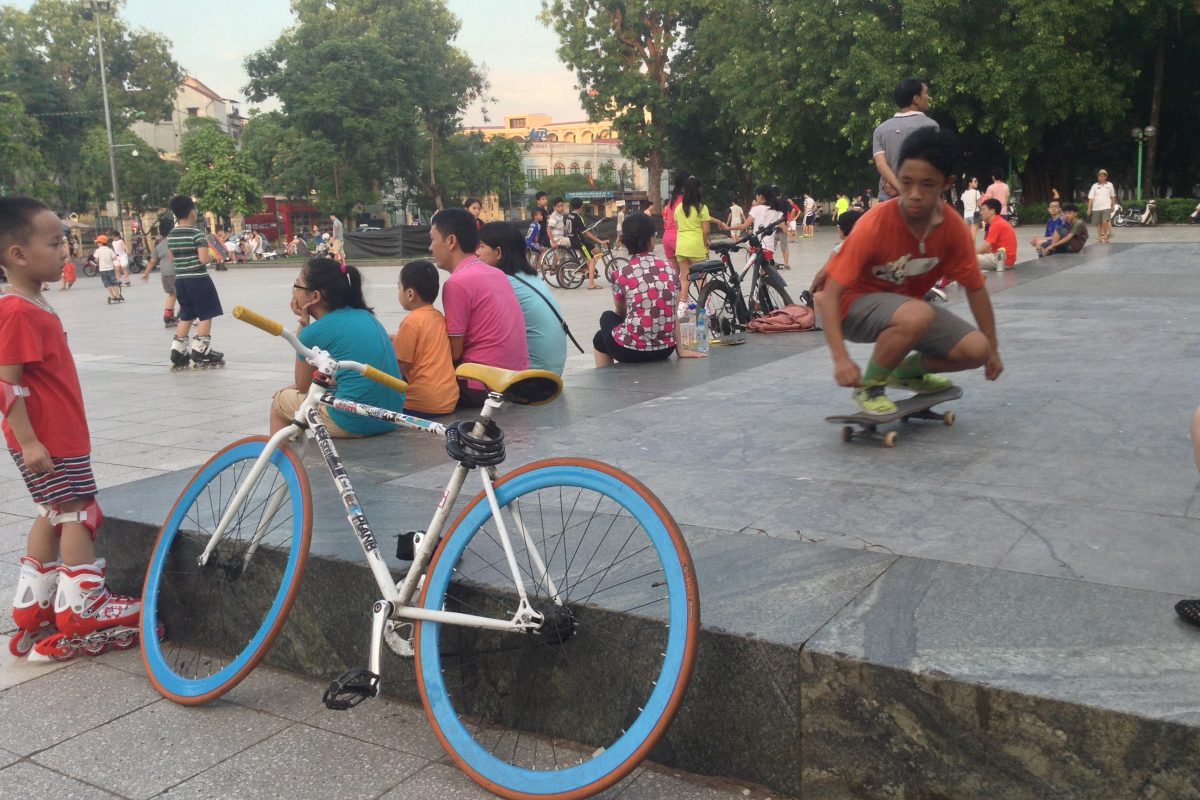
Keep up with our latest news and projects!

The use and meaning of Hanoi’s public spaces have undergone a profound change over the last three decades as Vietnam opened its doors to the market economy, and experienced major socio-economic reforms (Söderström & Geertman, 2013). Rapid urbanisation and densification has favoured a new use of public space and allowed for the flourishing of spontaneous urban youth practices. With the rapid growth of the city, the number of newly constructed public gardens and parks increased as well. At the same time, the city witnessed a dramatic decrease in the number of lakes and ponds and inner-city public spaces. Between 2000 and 2010, the city’s total park area declined from an already limited 2.09m2 per capita to just 1.48m2. (Boudreau et al. 2015, 2) Additionally, the vast majority of the new public spaces (and parks in particular) have limited accessibility as many of them are located too far out in the periphery, and have fences and entrance fees. As a result, the limited formal public spaces that remain in the inner city have become overcrowded.
In our study1, we learned that there are generally four main reasons why the formal public spaces in inner-city Hanoi were preferred by Hanoi youth over the new recreational parks developed (Boudreau et al. 2015). First, the accessibility of the inner city formal parks, they don’t have the entrance fees, fences and gates and they are located near the street. Second, the diverse physical setting of the inner city parks, this includes a flat, open, and hard surface which support their unstructured lifestyle sports activities. Third, due to the central location of these parks the youth feel they are part of society, they can interact with other people in society, this prevents loneliness (in particular for migrant youth) and they can assert their youthful lifestyles to an audience, so they can assert their youthful identities. Many youths told us they prefer a diverse mix of people, rather than developing youth-only parks (as developed elsewhere in the city). Fourth, youth prefer density, they like to be in a crowd, because it provides a more attractive atmosphere, they want to see others and be seen, interact and meet, as well they feel safer.
Claiming Hanoi’s inner-city formal public space for the practice of new urban activities has become a multifaceted challenge for youth. The spaces are formal, first because Hanoi’s urban administrative management defines this type of public spaces as công viên van hoá (cultural parks). This means they are public spaces not meant for recreational activities of citizens. These spaces are largely small pocket parks (called gardens) that have statues with a symbolic meaning that represent communist state authority. The flat hard surfaces in front of the statues are meant for political parades only. However, since 2000, and with an intensification since 2010, the youth have started to play an essential role in turning the inner-city formal pocket parks (meant to represent communist state authority), into centers that represent their everyday lives (Geertman et al. 2016).
In our study2 we learned that the success of the Hanoi youth in creating space for themselves in these formal urban spaces has been by relying on tactful negotiation strategies with the authorities in charge (police or guards): avoiding conflict as much as they could and by developing a broad awareness of others’ needs in terms of space (Geertman et al. 2016). In addition to securing space for play, they simultaneously did so to express their interests and identities to a larger society. Young people in Hanoi repeatedly speak of “cuôc sõng là nghê thuât” (living your life as art). It refers to a more free-flowing, less hierarchical, and more unpredictable life than what Vietnamese sociocultural values would typically allow for (Geertman and Boudreau, 2018). This means the space appropriation tactics by young people in Hanoi cannot just be analysed as survival practices. These youth space appropriation tactics are conscious acts of being present at the public spaces in ways that significantly has contributed in changing the socio-political meaning and use of these public spaces. As such, they can read as politics of the street, that elsewhere I have called everyday urban youth politics (Geertman et al. 2016). Whereas the authorities had not considered this as a serious threat, it did become one by 2015 when within a few days youth swiped the city away by becoming involved in street protests. The city government had started cutting trees in inner-city Hanoi but had not foreseen the consequences that could arise from this act. These trees were an essential part of these young people’s daily habitat, the formal public spaces that they earlier had appropriated for their practices for play (Geertman and Boudreau, 2018). Although a wide range of people from different generations became involved, it has been the youth who had an essential role in starting the mobilisation process. The youthful play had evolved directly into emotional environmental politics.
Although young people in Hanoi changed the meaning and use of public space in Hanoi and prevented many trees to be cut down in the city, dissatisfaction by youth in Hanoi remains. As in New York, London or Tokyo young people in Hanoi are still largely perceived as a threat to the social order. It remains to be seen if the state will continue to tolerate young people’s activities at these public spaces in Hanoi. This means that the youth in Hanoi will need to reinvent their negotiation strategies with the authorities continuously safeguarding the public spaces for their play every single day, now and in the future.
 Lenin Square : a small group of teenagers started to use the base of the Lenin statue for skateboarding in 2000, the year marks the beginning of a process that turned the square by 2010 into the center for youth lifestyle sports (e.g. skateboarding, hip-hop dancing,
inline skating) (Geertman et al. 2016). Source : Stephanie Geertman, 2015
Lenin Square : a small group of teenagers started to use the base of the Lenin statue for skateboarding in 2000, the year marks the beginning of a process that turned the square by 2010 into the center for youth lifestyle sports (e.g. skateboarding, hip-hop dancing,
inline skating) (Geertman et al. 2016). Source : Stephanie Geertman, 2015
This article belongs to a series of stories about the city at eye level for kids! You can access the full book online in PDF or pre-order your hardcopy to be delivered to your home.
Get your book here1. This research was conducted as part of the research project Youth-Friendly Public Spaces in a Context of Rapid Urbanization, funded for the period 2013–2015 by the Social Sciences and Humanities Research Council of Canada (SSHRC) for a collaborative project between the Institut National de la Recherche Scientifique (INRS, Canada), the Institute of Sociology of the Vietnamese Academy of Social Sciences (IoS- VASS, Vietnam), and HealthBridge (Vietnam and Canada)
2. The results presented here are based on the results of ethnic observations, 60 interviews and 11 group interviews with Vietnamese youth at three formal public spaces in the city Hanoi conducted between 2013-2015 (Boudreau et al. 2015).
– Boudreau, Julie-Anne, Laurence Charton, Stephanie Geertman, Danielle Labbé, Pham Thi Thanh Hien, and Dang Nguyen Anh. 2015. Youth-friendly Public Spaces in Hanoi. Research Report
– Geertman, Stephanie, and Julie-Anne Boudreau. 2018. “Life as Art”: Emerging Youth Networks in Hanoi and the Tree Hug Movement.” City & Society
– Geertman, Stephanie, Danielle Labbé, Julie-Anne Boudreau, and Olivier Jacques. 2016. “Youth-Driven Tactics of Public Space Appropriation in Hanoi: The Case of Skateboarding and Parkour.” Pacific Affairs 89 (3): 591–611.
– Söderström, Ola, and Stephanie Geertman. 2013. “Loose Threads: The Translocal Making of Public Space Policy in Hanoi.” Singapore Journal of Tropical Geography 34 (2): 244–6